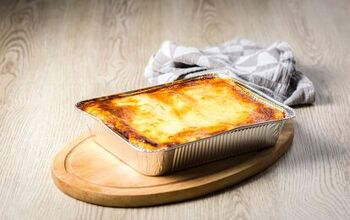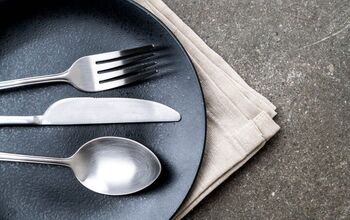Can You Put Aluminum Foil In The Microwave? (Find Out Now!)

Aluminum foil is great wrap. It can keep food fresh and protect it from air, sunlight, bacteria, and fruit flies. Some individuals prefer aluminum foil over cellophane wrap because it’s thicker and easier to mold.
If you have something wrapped in aluminum—and you need to warm it up quickly—then you may think of popping it in the microwave for about 30 seconds so it can heat up. But you need to be careful when doing this, as aluminum can create a lot of problems, for the microwave specifically, if it is not microwaved properly.
Some say you shouldn’t use aluminum in the microwave at all, but others insist there are ways to do this. Their methods, as well as the reasons behind the objections, will be discussed in this article.
Yes, you can put aluminum foil in the microwave, but you need to be careful when you do this. There are specific things you should avoid, and whenever you put aluminum foil in the microwave, you should be right there to watch it. If you notice sparks, flames, or the smell of burning, you should take the aluminum foil out immediately.
Do You Need Appliance Repair Services?
Get free, zero-commitment quotes from pro contractors near you.

What Is Aluminum Foil and Why Is It Used?
When aluminum slabs are rolled in a rolling mill, the result is aluminum foil. Aluminum foil will provide a complete barrier from light, oxygen, moisture, and bacteria. This is why it’s used so often with food and pharmaceutical packaging. It is also used to make aseptic packaging, and this can be used to store perishable goods without a refrigerator.
Aluminum foil first appeared on the market in 1948, and these days you can find it in virtually every supermarket. It really took off in the 1950s and 60s, and back then you’d find TV dinners and other common food products wrapped in aluminum foil.
These days, there are three main kinds of aluminum foil: household, semi-rigid, and flexible. Household aluminum foil is the focus of this article, and it’s used for food preparation, insulation, conducting electricity, and art/decoration.
Operating a Microwave: The Basics
Microwaves run on friction. That is, they generate radio waves which cause friction, and this friction makes food and water heat up. Foods and liquids both have conductive properties, and these are what allow heat to generate within.
When metal is put inside a microwave, these waves will be reflected, and this can create a problem for the system. A microwave is basically a big metal box that’s used for cooking, and it’s enclosed so these radio waves don’t escape and cause problems.
Is Aluminum Foil Like Thick Metal?
If you put a piece of metal in the microwave, like a frying pan, then the waves generated by the machine will essentially bounce all around, as they won’t be absorbed by the pan. But a thin piece of metal like aluminum foil is different. This doesn’t have reflective properties, so it may heat up and ignite if it’s in the microwave too long.
If a current goes through the foil, you may witness sparks and a burning smell as well. Most microwave users will learn the hard way about putting metal in the microwave, as most users don’t know ahead of time what’s going to happen.
So does this mean you can never use aluminum foil in the microwave? Well, there are some ways around this, and these ways will be discussed below.
Making Aluminum Foil Microwave-Safe
While most individuals think aluminum foil is not microwave-safe, there are some ways you can use aluminum foil in the microwave. Don’t stray from these recommendations, as you may damage your system.
Avoid Fully Wrapping Items in Foil
You shouldn’t put food that’s completely wrapped in aluminum foil in the microwave, as in this state the food won’t be able to absorb the microwaves and therefore it won’t be able to heat up. This could also damage the microwave and/or cause burning.
Using Small Aluminum Foil Shields
You can, however, use small pieces of aluminum foil as shields, and this is done to prevent overcooking. Think about if you’re putting poultry in the microwave and you want to protect the wings and drumsticks.
There’s also foil-wrapped packaged food that’s microwave-safe, and here you just want to make sure you read the manufacturer’s instructions before you begin microwaving. In a microwave, things heat from the top, so it’s best to stay away from reheating things that are beyond two inches thick.
Sometimes, you’ll notice that food is not hot near the bottom after you take it out of the microwave. If you’re trying to get something thoroughly cooked, then perhaps you should use an oven (if one is available to you).
What Else Can Be Microwaved in Addition to Foil?
While aluminum foil is probably the most common kind of aluminum product used in the kitchen, other aluminum-based items are used frequently as well. For the most part, one can use these items in the microwave, but there may be times when you’re not able to.
For this reason, you should always consult the manufacturer’s instructions before you use any of these items in the microwave. Most of these items are disposable too, so you can get rid of them—if this is what you wish—after putting them in the microwave.
One thing you should keep in mind is that if you leave these items in for too long, they could get bent or warped by the microwave. If we’re talking about cake pans, bread tins, and steam table pans, you should avoid taking the risk, as ruining these items could set you back a few bucks.
The Argument Against Tin Foil in the Microwave
The main reason why a lot of individuals advise against putting aluminum foil in the microwave is because a thin piece of aluminum foil can get hot very quickly and even light on fire. And because a microwave is a metal box, heating will be accelerated, and if you’re heating food then this could ignite along with the aluminum foil.
If a fire is started in your microwave and you aren’t there to notice it right away, the problem could get out of hand quite quickly. A small, containable fire could turn into an electrical blaze in mere seconds, and the fire may escape the confines of the microwave and spread throughout your home.
In such a situation, you may not be alerted until it’s too late, and this is why it’s generally recommended to stay away from using tin foil in the microwave. If you have to do so, you should just watch it carefully; this way you can pull it out if you start to see sparks flying or smell burning.
Do You Need Appliance Repair Services?
Get free, zero-commitment quotes from pro contractors near you.

Related Questions
What shouldn’t go in the microwave?
You should avoid putting paper bags and cardboard in the microwave. If either material is left in too long, a fire could be started. Metal-based items, which were the focus of this article, should also stay out of the microwave. Plastic that is not deemed safe should also be kept out, as it can bend, melt, or even explode.
Is styrofoam microwave-safe?
Additionally, you should refrain from putting styrofoam in the microwave. Doing so could be harmful to the environment, to yourself, and to others in your home. Also, don’t run a microwave when nothing is inside; doing this could start a fire.
Related Guide

Matt loves everything DIY. He has been learning and practicing different trades since he was a kid, and he's often the first one called when a friend or family member needs a helping hand at home. Matt loves to work with wood and stone, and landscaping is by far his most favorite pastime.
More by Matthew Mountain



























